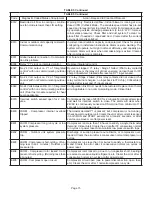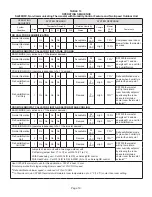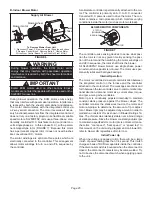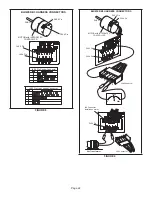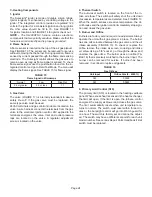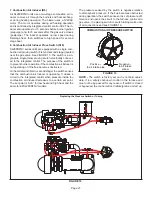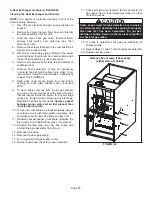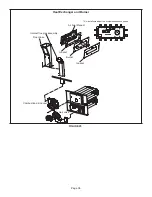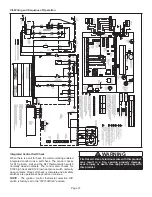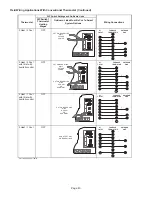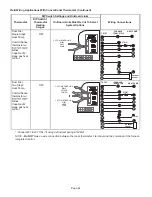
Page 29
Gas supply piping should not allow more than 0.5”W.C.
drop in pressure between gas meter and unit. Supply gas
pipe must not be smaller than unit gas connection.
Compounds used on gas piping threaded joints should be
resistant to action of liquefied petroleum gases.
C-Testing Gas Piping
IMPORTANT
I
n case emergency shutdown is required, turn off
the main shut-off valve and disconnect the main
power to unit. These controls should be properly
labeled by the installer.
When pressure testing gas lines, the gas valve must be
disconnected and isolated. Gas valves can be damaged if
subjected to more than 0.5 psig (14” W.C.). See FIGURE
18. If the pressure is greater than 0.5psig (14”W.C.), use
the manual shut-off valve before pressure testing to iso
-
late furnace from gas supply.
MANUAL MAIN
SHUT-OFF VALVE
WILL NOT HOLD
NORMAL TEST
PRESSURE
CAP
ISOLATE
GAS VALVE
FURNACE
1/8 NPT PLUG
FIGURE 18
When checking piping connections for gas leaks, use
preferred means. Kitchen detergents can cause harmful
corrosion on various metals used in gas piping. Use of a
specialty Gas Leak Detector is strongly recommended. It
is available through Lennox under part number 31B2001.
See Corp. 8411-L10, for further details.
Do not use matches, candles, flame or any other
source of ignition to check for gas leaks.
D-Testing Gas Supply Pressure
IMPORTANT
For safety, connect a shut-off valve between the
manometer and the gas tap to permit shut off of gas
pressure to the manometer.
A port on the inlet side of the gas valve provides access
to the supply pressure tap. See FIGURE 17. Loosen the
screw and connect a manometer to measure supply pres-
sure.
The minimum supply line pressure is 4.5” - 13.0”w.c. For
natural and 11.0 - 13.0” wc for LP/Propane. Tighten after
measurements have been taken.
E- Proper Gas Flow (Approximate)
Furnace should operate at least 5 minutes before check-
ing gas flow. Determine time in seconds for two revolu
-
tions of gas through the meter. (Two revolutions assures
a more accurate time.) Divide by two and compare to time
in table 17 below.
NOTE-
To obtain accurate reading, shut off all other gas
appliances connected to meter.
TABLE 17
GAS METER CLOCKING CHART
Unit
Seconds for One Revolution
Natural
LP/Propane
1 cu ft
Dial
2 cu ft
Dial
1 cu ft
Dial
2 cu ft
Dial
-060
60
120
150
300
-080
45
90
112
224
Natural - 1000btu/cu ft Propane-2500 btu/cu ft
F-Check Manifold Pressure
IMPORTANT
For safety, connect a shut-off valve between the
manometer and the gas tap to permit shut off of gas
pressure to the manometer.
Manif
old and Signal Pressure Check
1 -
Turn off the electrical power and gas supply to the
furnace.
2 - Remove the threaded plug from the outlet side of
the gas valve and install a field-provided barbed
fitting. Connect measuring device positive “+” to
barbed fitting to measure manifold pressure. See
FIGURE 17 for manifold location.
3 - Install hoses and meter as shown in FIGURE 20 for
signal pressure measurement.
4 -
After allowing unit to stabilize for 8 minutes, record
manifold pressure and compare to value in TABLE
18 or TABLE 19. If manifold pressure is within
range, rate check is complete move to step 6. If
manifold pressure is not within range continue.
Valve is not adjustable. Do not adjust manifold
pressure.
5 - Record signal pressure and compare to value in
TABLE 18 or TABLE 19. If signal pressure is within
range continue. If the signal is not within range go
to “Troubleshooting”.
6 -
Shut off unit and remove manometer and signal
meter after accurate readings has been obtained.
7 -
Restart unit and check for gas leaks. Seal any leaks
found.
If the unit has difficulty igniting or ignites with loud
resonance the air orifice must be checked and re
-
placed if necessary.

